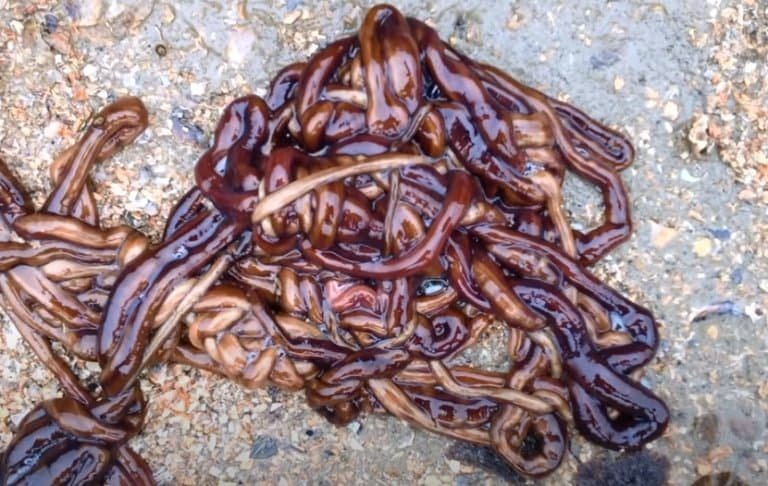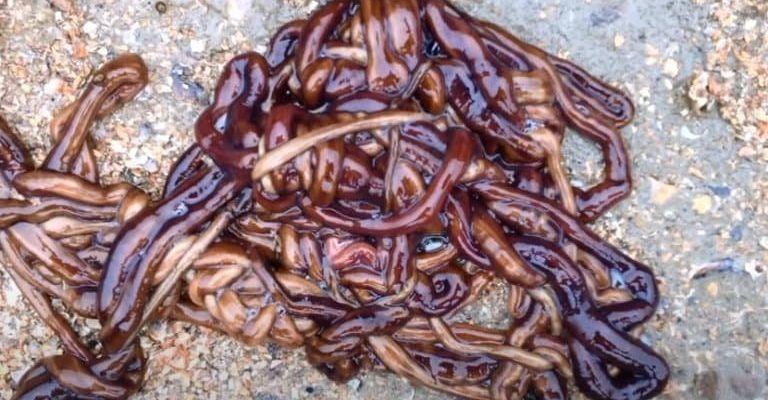
Bootlace worms, belonging to the species *Lineus longissimus*, live primarily in the cold waters of the North Atlantic and are often found in the mud or sand. Despite their impressive length, they’re slender and not much thicker than a pencil, leading some to call them “bootlace” due to their resemblance to shoelaces. You might be wondering: how do they grow so long? What’s the secret behind these remarkable creatures? Let me explain.
What Are Bootlace Worms?
Bootlace worms are part of the marine polychaete family, specifically in the class *Annelida*. This class includes segmented worms, which means their bodies are arranged in a series of repeating segments. These worms usually live in coastal areas, hiding in sediment or among seaweed, where they can be somewhat hard to spot.
Their bodies are made of soft, flexible tissue, allowing them to extend and contract as needed. This unique body structure is crucial for their survival, as it helps them move through the ocean floor. The way they wiggle and squirm is kind of mesmerizing! They create a sort of “undulating” motion that helps them navigate their underwater environment. Honestly, it’s like watching a ribbon dance in the wind, flowing gracefully through the water.
How Do Bootlace Worms Grow So Long?
The growth of bootlace worms is quite fascinating. They achieve their incredible lengths through a process called *asexual reproduction*, which means they can produce offspring without a mate. This process involves fragmentation, where a part of the worm can break off and develop into a new individual. You might think of it like how a plant can grow a new sprout from a single leaf!
In addition to fragmentation, bootlace worms have incredible regenerative abilities. If they lose a segment of their body, they can regrow it! This ability not only allows them to recover from injuries but also helps them grow longer over time. As they grow, they add new segments to their bodies, leading to those impressive lengths you might have heard about. Imagine how many new segments a worm can add in just a few years—it’s mind-blowing!
Where Are Bootlace Worms Found?
Bootlace worms thrive in cold marine environments, typically found in the North Atlantic Ocean. They prefer shallow waters, usually near the coast, where they can burrow into soft sediments. This habitat provides them with protection from predators, as it can be tricky for larger animals to dig into the mud.
You may find them hiding in seaweed or amongst rocks and shells, making them a bit sneaky! The muddy ocean floor is like their personal playground, allowing them to extend their bodies and navigate through various obstacles. When exploring tidal pools or coastal areas, keep an eye out for these creatures; they might just be lurking where you least expect them!
The Ecological Role of Bootlace Worms
Bootlace worms play an important role in their ecosystems. They help maintain the health of the ocean floor by aerating sediment and breaking down organic material. This process is vital for nutrient cycling in the marine environment. Think of them as nature’s recyclers—cleaning up waste and helping to keep the ecosystem balanced.
In addition, they serve as food for various marine species. Predators like fish and birds may snatch up bootlace worms as a snack. This makes them an integral part of the food chain, contributing to the overall health of their marine habitat. So, the next time you think about bootlace worms, remember they’re not just long and slender; they are hardworking little creatures doing their part for the ocean!
Interesting Facts About Bootlace Worms
Here are a few fun tidbits about bootlace worms that you might find surprising:
- They Can Regenerate: Bootlace worms can regrow lost segments and even reproduce by fragmentation, making them quite resilient.
- They Are Slender: With a body diameter of just a few millimeters, they can be quite hard to spot, even at remarkable lengths.
- Color Variations: They can come in different colors, like brown, yellow, or even green, depending on their environment.
- Myth or Fact: Some people believe they can grow much longer than 50 meters under the right conditions, although that’s yet to be scientifically confirmed!
These little-known facts make bootlace worms even more intriguing. They’re not just remarkable for their length; they also have a range of unique abilities that help them survive and thrive.
Comparing Bootlace Worms to Other Long Animals
When we talk about length in the animal kingdom, bootlace worms aren’t the only contenders. For example, jellyfish, specifically the lion’s mane jellyfish, can also reach impressive lengths with their long tentacles. However, while jellyfish float along the surface, bootlace worms lie hidden in the ocean floor, leading very different lives.
Another fascinating comparison is with the blue whale, the largest animal on Earth. While the blue whale outmatches the bootlace worm in overall mass, the worm takes the crown for length. This kind of comparison really puts into perspective how diverse and varied life can be in different environments.
Why Study Bootlace Worms?
Studying bootlace worms is crucial for understanding marine ecosystems. They help scientists learn more about nutrient cycling, regeneration, and the overall health of ocean environments. Each discovery leads to greater insights about how life in the ocean functions and interacts.
Moreover, understanding creatures like bootlace worms can contribute to conservation efforts. By knowing how these animals live and thrive, we can better protect their habitats. Since many marine ecosystems are facing challenges like pollution and climate change, every bit of knowledge helps us make informed decisions about how to preserve these precious environments.
Bootlace worms are truly a marvel of nature, showcasing how fascinating life can be in the depths of our oceans. From their incredible lengths to their unique reproductive strategies, these creatures remind us of the wonders of the natural world.
Next time you think about the ocean, remember the bootlace worm and its role in keeping marine ecosystems balanced. Whether you’re exploring the beach or diving deep into your research, these long, slender animals have a lot to teach us. So, let’s keep discovering and appreciating the unique life that resides beneath the waves!

